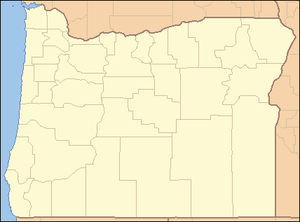- Dry River (Crooked River)
-
Dry River Country United States State Oregon County Deschutes and Crook counties, Source near Hampton Buttes - location Deschutes County, Oregon - elevation 5,886 ft (1,794 m) [1] - coordinates 43°46′56″N 120°16′44″W / 43.78222°N 120.27889°W [2] Mouth Crooked River - location west of Prineville, Crook County, Oregon - elevation 2,782 ft (848 m) [2] - coordinates 44°20′10″N 121°02′50″W / 44.33611°N 121.04722°W [2] Length 88 mi (142 km) [3] Basin 752 sq mi (1,948 km2) [4] The Dry River is an intermittent tributary, 88 miles (142 km) long,[3] of the Crooked River in the U.S. state of Oregon. The stream arises near Hampton Buttes north of Hampton and U.S. Route 20 between Brothers and Riley in the Oregon High Desert. Beginning in eastern Deschutes County near its border with Crook County, it flows generally northwest along the Deschutes–Crook county line, crossing briefly into Crook County before turning slightly south and returning to Deschutes County. Along these upper reaches, it flows roughly parallel to the highway, under which it passes several times before turning sharply north near the Horse Ridge Research Natural Area, 19 miles (31 km) southeast of Bend. Continuing north and re-entering Crook County, it passes under Powell Butte Highway, Oregon Route 126 (Ochoco Highway), and Oregon Route 370 (O'Neil Highway) before entering the Crooked River 34 miles (55 km) from the larger stream's confluence with the Deschutes River.[5][6]
Oregon Geographic Names says that the dry channel of the river, which runs in places between walls of basalt, is clearly marked for more than 50 miles (80 km), from the west end of the desert to the Crooked River.[7] Dry River Canyon, a deeply incised stretch of the river bed near Millican, is used as a hiking path, about 2.3 miles (3.7 km) long.[8] The canyon was carved during the wetter climate of the Pleistocene epoch by water flowing from a now-vanished lake in the Millican Valley.[8][9] Canyon walls in this stretch rise 300 feet (91 m) above the sandy bed of the river.[9] Other sights include large boulders, juniper trees, and Native American petroglyphs.[8]
See also
- List of rivers of Oregon
- List of longest streams of Oregon
References
- ^ Source elevation derived from Google Earth search using GNIS source coordinates.
- ^ a b c "Dry River". Geographic Names Information System. United States Geological Survey. November 28, 1980. http://geonames.usgs.gov/pls/gnispublic/f?p=gnispq:3:::NO::P3_FID:1141354. Retrieved September 3, 2010.
- ^ a b "National Hydrography Dataset". United States Geological Survey. http://nhd.usgs.gov/index.html. Retrieved September 3, 2010.
- ^ "Watershed Boundary Dataset". USDA, NRCS, National Cartography and Geospatial Center. http://www.ncgc.nrcs.usda.gov/products/datasets/watershed/. Retrieved September 4, 2010.
- ^ DeLorme Mapping. Oregon Atlas & Gazetteer (Map) (1991 ed.). Section 45, 76, and 51. ISBN 0-89933-235-8.
- ^ United States Geological Survey (USGS). "United States Geological Survey Topographic Map". TopoQuest. http://www.topoquest.com/map.php?lat=44.33727&lon=-121.04758&datum=nad83&zoom=8&map=auto&coord=d&mode=zoomout&size=m. Retrieved September 8, 2010. The relevant map quadrants from mouth to source are: O'Neil, Powell Butte, Alfalfa, Horse Butte, Millican, Pine Mountain, West Butte, Millican SE, Brothers SW, Brothers, and Imperial Valley North, all in Oregon.
- ^ McArthur, Lewis A.; McArthur, Lewis L. (2003 [1928]). Oregon Geographic Names (7th ed.). Portland: Oregon Historical Society Press. ISBN 0-87595-277-1.
- ^ a b c "Dry River Canyon". The Bulletin. Western Communications. September 8, 2009. http://www.bendbulletin.com/apps/pbcs.dll/article?AID=/20090918/AE/909180309/1049/SPORTS&nav_category=SPORTS. Retrieved September 8, 2010.
- ^ a b Sullivan, William L. (2002). Exploring Oregon's Wild Areas (3rd ed.). Seattle: The Mountaineers Press. ISBN 0-89886-793-2.
Categories:- Rivers of Oregon
- Landforms of Crook County, Oregon
- Landforms of Deschutes County, Oregon
Wikimedia Foundation. 2010.

